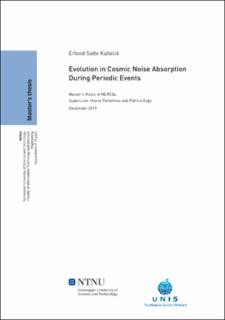| dc.description.abstract | The evolution of energetic electron precipitation in the ionosphere above Lapland was examined by using 5 magnetometers and 3 riometers in the period from 2008 to 2013. The magnetometers gave rise to the IL index, which defined the phases and the intensity of the substorms. The amount of cosmic noise absorption was evaluated with respect to the substorm intensity. During this 6-year period period, 245 event were evaluated. 79 of them occurred as single night events, while the remaining 166 came in groups of at least 2 nights in a row. The substorms were classified into intensity categories of either -400, -600 or -800 nT.
The single night events were divided into isolated and compound substorms, depending on the number of expansion and recovery phases. Each event night in the multi-night events was evaluated from the first expansion phase to the last recovery phase. The event nights had an average duration of about $8\pm3$ hours around midnight, which is the time sector where the IL index records at least 80 \% of the global magnetic activity. This makes the IL index a good reference for co-located riometers, even for these very long event nights.
A linear correlation between cosmic noise absorption and substorm intensity was found when averaging from start to end of each event night. However, this linearity breaks down when the events are examined in detail. Relative to the strength of the magnetic disturbance, there seems to be a higher cosmic noise absorption in the late night and early morning sector. This is especially important for the events with the most intense substorms.
During multi-night events, the cosmic noise absorption often showed higher values for the second to fourth night. This behaviour can also be caused by external factors like the solar wind and geomagnetic storms. Thus, the Dst index and solar wind data should be included in future studies.
Finally, these substorm events are associated with electron precipitation with high enough energy to ionise neutral species in the atmosphere. Earlier studies have shown that such events can alter the atmospheric chemistry on a short term scale. The occurrence rate of such events is so high, that the precipitation may be a significant player in atmospheric chemistry. | |

